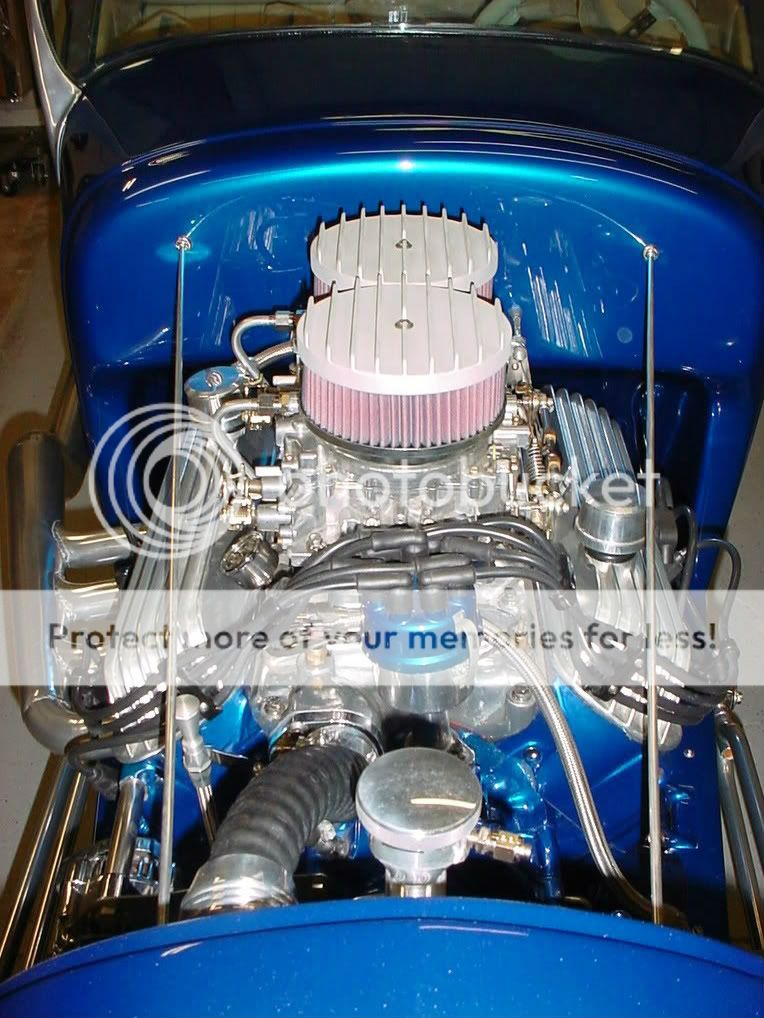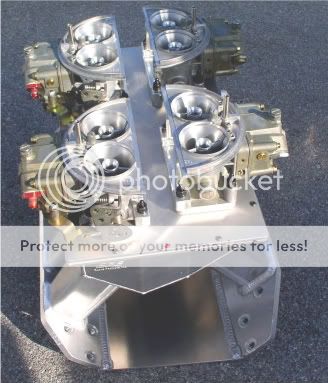Zack, you're asking a lot of the same questions you were asking in the other thread.
What you're missing in the equation is that you need to provide some answers to some of the questions others have asked you.
Those were 500 CFM carbs in the other thread. Are they now, in fact, 600 CFM models?
You need to understand two facts. 1. That intake was not designed to be used on a street-driver. 2. You have far too much carburetor for what you're trying to do. You cannot escape those facts. All you can do is try to make things work as well as possible.
Step Number 1 - Quit trying to second-guess things.
Step Number 2 - Start testing things, so you will have hard data to work with, instead of guesses, ideas and generalities.
Answer? Who knows? Have you checked fuel pressure, to verify it is set at 6 psi or lower? Because that is quite likely the root of all your problems. But there is no way to know that for sure, because nobody knows where it is currently set.
So how can you change something, when you have absolutely no idea that is the cause of the problem?
Losing fuel balance to various cylinders. The common plenum on your intake choice will cover up some of the problem, but not all of it. You hide a lot of it by running on the rear carb alone, rather than the front carb alone, but balance will be affected.
If you feel disabling the front carb is the fix for your combination, you be absolutely sure you lock the throttle blades in the closed position. Otherwise, you're going experience over-heating, running lean and have all the fixings for a run-away motor.
You can tune what you have, so it will work reasonably well. Would you walk into a restaurant and order two steak dinners, when you have intentions of eating only one?
The mechanical secondaries on an Edelbrock carb shouldn't be confused with the mechanical secondary Holley carbs, which also use a secondary
crutch, errr, accelerator pump. The secondary side of an Edelbrock carb is not going to flow any air/fuel until the weighted, secondary air valve opens.
Here are some specific questions for you -
1. Have you verified your fuel pressure setting? If not, why in the Dickens are you trying to sort what your problem might be? The problem might be (and likely is) excessive fuel pressure.
2. You said the engine builder ran this engine on a dyno or a test stand and that it ran fine. Did you have eyes and ears on this test session, or are you taking the engine builder's word at face-value?
3. You said the engine builder ran the engine with his intake. What intake was that? And what carburetor/s did he use?
4. You said the engine builder ran the engine with his electrics, which I presume means his ignition system. What system was that?
5. I've tried wading through the other post and the answer doesn't jump off at me. Are you experiencing these problems with the car sitting in your shop idling, or whilst driving the car?
6. I asked if you have hooked up a vacuum gauge and you replied in
this post with what sound like cranking compression numbers. Have you had a vacuum gauge hooked up? If yes, what kind of readings did you record?
From everything you have written to date, a reasonable
guess is your fuel pressure is excessive. But please note, that is nothing more than a guess. There's no way to know that is a problem, until you have actually checked it. So do yourself a favor and verify that number, before you move any farther. You can change everything under the sun, but
none of those changes are going to work, if fuel pressure is excessive.
I'm really getting the impression all of this is being experienced with the car sitting in your shop. If it is, take all the advice about jet changes, step-up rod changes and spring changes and
throw them out the window. When a car is idling, it is flowing fuel through the idle circuit and NOT the main jets. Get things working well on the idle circuit before you start making wholesale changes to the accelerator pump circuit and main jet circuit.
Ben gave you a good piece of advice on the progressive carb linkage. You are going to want to use progressive linkage. But you need to fix the problem you already have before you start down that path.
John offered a valuable suggestion. If you simply cannot see the light of day, call the Edelbrock tech line. Those people are getting paid to help you diagnose problems and fix them to your satisfaction. But you need to get your ducks in a row before you reach for the phone. Trust me, it can be nearly impossible to identify a problem, when a customer fails (or refuses) to provide real data. Those techs are going to ask you some specific questions and they are expecting you to give them specific answers. And trust me, one of the first questions they will ask is where fuel pressure is set. If you do not know the answer, they cannot diagnose anything. If you think fuel pressure is about this or that, you are not providing real data and the diagnostic process just came to an end. People would call and tell me they
thought they had a 1.75 rocker ratio and their lobe lift was
about .515" and their installed height was
about 2.200". Which told me nothing, so my
thought would turn to how the phone call was
about over.
Tell us your fuel pressure setting. Tell us if you were present during the engine test. Tell us what intake and carb/s were used during that test. Tell us what ignition system he used, compared to what you are now using. Tell us if these problems are manifesting themselves in the shop, out on the open road or both. Tell us what kind of vacuum reading you have seen/recorded. And don't approximate anything, tell us real-world numbers, so we can evaluate what those numbers are telling us.
You can make things work, but you're going to have to leave the shotgun approach to someone else and get your focus narrowed down to identifying problems, one at a time. And then fixing them, one at a time. And ignoring everything else that might disrupt the process.













